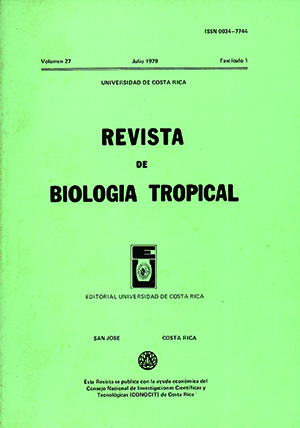Abstract
The stingless bee, Trigona angulata fribrigi Schwartz, predominantly nested in radical cavities of at least 2 8 tree species in central Paraguay, but were more prone to predation by humans than nests located in trunk cavities. Colonies were randomly dispersed and occured at a density of 3.7 ± 4.3 colonies/ha. Multiple regression analysis revealed that temperature, time of day, and relative humidity explained a significant amount of seasonal colony foraging intensity (R2 = 0.66). Over seasons, colony foraging intensity and the number of flowering herbs and trees were canonically correlated with mean temperature, relative humidity, month and hours of available sunlight.
References
Barr, A. J., J. H. Goodnight, J. P. Sall, & J. T. Helwig. 1976. A user's guide to SAS 76. SAS lnstitute. Raleigh, North Carolina.
Corbet, S. A. 1978. Bee visits and the nectar of Echium vulgare L. and Sinapis alba L. Ecol. Ent., 3: 25-37.
Darchen, R. 1972. Ecologie des quelques trigones (Trigona sp.) de la savane de Lamoto (Cote d'lvoire). Apidologie, 3: 341-367.
Heithaus, E. R. 1974. The role of plant-pollinator interactions in deterrnining cornmunity structure. Ann. Mo. Bot. Gard., 61: 675-691.
Hubbell, S. P., & L K . Johnson. 1977. Cornpetition and nest spacing in a tropical stingless bee community. Ecology, 58: 949-963.
Johnson, L. K., & S. P. Hubbell. 1974. Aggression and competition among stingless bees: field studies. Ecology, 55: 120-127.
Morisita, M. 1962. lo -index, a measure of dispersion of individuals. Res. Pop. Ecol., 4: 1-7.
Morrison. D. F. 1976. Multivariate statistical methods. 2d ed. McGraw Hill, New York. 415 p.
Park, O. W. 1929. The influence of humidity upon sugar concentration in the nectar of various plants. J. Econ. Ent., 22: 534-544.
Ribbands, C. R., 1953. The behavior and social life of honey bees. Bee Res. Assn. Ltd., London.
Vansell, G. ID, W.G. Watkins, &. R. K. Bishop. 1942. Orange nectar and pollen in relation to bee activity. J. Econ. Ent., 35: 321-323.
Wille, A., & E. Orozco. 1975. Observations on the founding of a new colony by Trigona cupira (Hymenoptera: Apidae) in Costa Rica. Rev. Biol. Trop., 22: 253-287.
Comments

This work is licensed under a Creative Commons Attribution 4.0 International License.
Copyright (c) 1979 Revista de Biología Tropical


